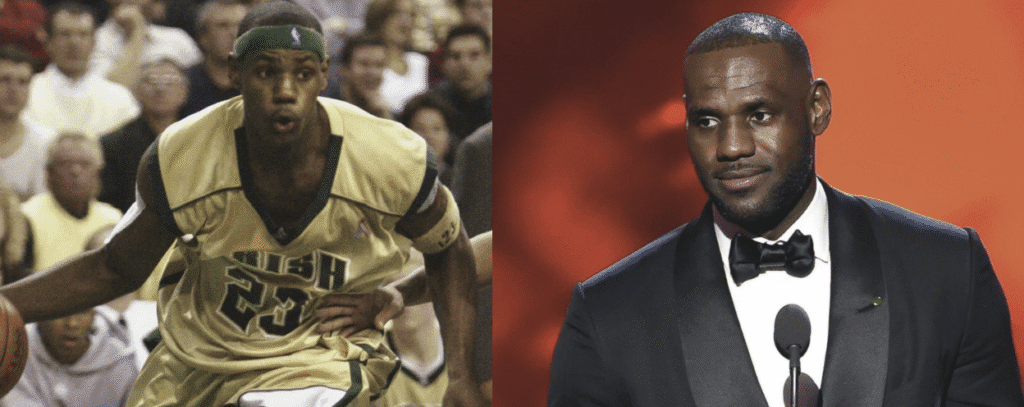How LeBron James Went from Couch-Surfing with His Mom to Finding Stability, Hope, and a Love for Basketball That Changed Everything

Rooted in Struggle, Blossomed by Hope
I want you to picture Akron, Ohio, in the mid-1980s: a hardworking Rust Belt town where dreams often whisper beneath the hum of factories. Now, imagine a teenage mother, Gloria James, just 16 years old, cradling her newborn son, LeBron, in a small apartment that often felt too big for comforts and too small to hold the hope she carried. LeBron Raymone James entered the world on December 30, 1984, in that fragile space. His young mother had no partner to lean on and only the instinct to protect and nurture her child against the odds.
Before LeBron even turned three, the foundation beneath them shattered. On Christmas Day when he was three years old, Gloria’s mother, the anchor of that early refuge, died suddenly of a heart attack. That loss marked a turning point: the home was lost, and from then on, Gloria and LeBron drifted through apartments, living couch to couch, sometimes homeless, constantly chasing stability. There were times when Gloria’s work and efforts couldn’t erase the feeling in young LeBron’s mind, that he might wake up and discover she was gone. He missed many months of school, a testament to how chaotic and unsafe life had become.

But through those unsettled days, basketball was there waiting. At nine years old, LeBron’s life quietly began to shift when he was given a priceless gift: his pee-wee football coach, “Big Frankie” Walker, offered a helping hand. He invited LeBron to move into his home in suburban Akron, so Gloria could figure things out and still visit her son on weekends. It was an act of profound kindness and a chance for the boy to find roots, however temporary.
That home, full of warmth and routine, became a turning point. For the first time in a long while, LeBron was consistently in school, safe, and free to explore his energy and curiosity. It was around that time he found a basketball, a plain, simple ball, but it soon became his anchor. He discovered that he could lose himself in the rhythm of dribbling and shooting, in the echo of a bouncing ball on asphalt. It was the kind of sanctuary that only basketball could offer a young boy whose world had known instability and fear.

The coach’s home wasn’t just a place to sleep. It was where Frank and Pam Walker introduced LeBron to the structure he’d never had. Where the rules of school attendance made sense again, and the idea that education mattered took hold. Coach Walker insisted on effort, discipline, and consistency. And though this arrangement strained both men and boy at times, it was about love, not convenience.
From that fragile beginning, LeBron’s love for basketball blossomed. He joined AAU ball as part of the “Shooting Stars,” a small traveling team coached by Dru Joyce II, fondly known as “Coach Dru,” a local youth coach who recognized something rare in a lanky kid from Akron. Alongside close friends Sian Cotton, Dru Joyce III, and Willie McGee, they formed a makeshift band of brothers, promising to stick together, share dreams, and lift one another. They came to call themselves the “Fab Four,” and they lit up local and national AAU tournaments with their chemistry, hunger, and ambition.

LeBron’s school attendance improved, and his grades followed. More importantly, a sense of identity began to take root. In the chaos of his early childhood, the most important thing to him was knowing that his mother was alive and safe. But now, standing on an indoor court, ball in hand, he felt connected to something bigger: a team, a community, a future he could shape. That small basketball court, held together by the sweat and spirit of neighborhood kids, became the place where fear began to lose its hold on him.
Some years later, a teenage LeBron walked the halls of St. Vincent–St. Mary High School in Akron, flanked by his AAU brothers. Under Coach Dru and legendary coach Keith Dambrot, the high school team rose to national prominence, winning state titles and capturing imaginations across the country. But those simplified triumphs started with that kid who just wanted a safe place to sleep, a steady meal, and a ball to soothe his soul.
And every step of the way, Gloria James’s fierce love, Frankie Walker’s kindness, Coach Dru’s guidance, they were all threads sewn into the fabric of what would drive LeBron James into stardom. He never forgot: this was where he came from, what he overcame. And as he ascended on the court, his heart remained tethered to Akron and the people who helped him dream beyond survival.

The Foundation Behind Greatness
There’s something tender about knowing that LeBron James, long before record books and championships, was just a boy chasing his mom’s return, finding solace in bouncing rubber, a kid learning that school matters and structure brings hope. His story reminds me that sometimes, life’s most profound moments happen not in glittering arenas, but in small acts of trust: a coach’s home, a borrowed ball, a team of friends who believed in a boy who had seen too much unsteady ground.
His journey wasn’t scripted, and it didn’t unfold on TV. It unfolded in Akron’s apartments, on cracked basketball courts, around a dinner table at the Walkers, under the watchful eyes of coaches who treated him like hope made flesh. His rise to greatness was built on vulnerability, on a single mother’s fierce love, on strangers who gave him a chance, on a community that believed he might just be something extraordinary.
And of course, he became extraordinary. But it all started with that boy, tangled in the streets of Akron, learning to dribble away fear. That’s the LeBron before the legend.